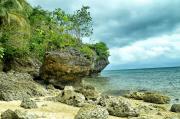
The construction of magnificent churches in Dingras town is part of the town’s establishment during Spanish era. Today the remains of these colonial churches, ancestral houses and cemeteries are picturesque reminders of the town's spirited Spanish-influenced past. Here are some historical landmarks of the town that proudly displays Ilocos Norte’s role in history:
Dingras Church Ruins
- One of the town’s tourist attractions, it is usually the place where historical and cultural shows are held. It is one of the largest and oldest churches built during the Spanish regime
Many Dingrenios are Catholics. Their place of worship was constructed when the old Catholic Church was ruined by the war and the elements.
Ancestral Homes
- The ancestral home of Gregorio Puruganan, Floor Leader and Delegate of the Second District of Ilocos Norte to the 1971 Constitutional Convention, a nationally known poet and writer and an outstanding practicing lawyer.
Tabaclera Building
- This was the Spanish tobacco warehouse which manifested an intensive tobacco cultivation in Dingras Valley which included towns of Marcos, Solsona, Espiritu, Pinili and Nueva Era.
The St. Joseph Institute
- It is a very sturdy structure made out of bricks and is now utilized as a private secondary school building
The Roman Catholic Cemetery
- The Catholics of Dingras have a high respect for the dead, hence this cemetery was built during the Spanish era as revealed by the brick walls. Here, masses are held on All Saints’ Day and All Souls’ Day.
How to get there
From Manila, you can get to Ilocos Norte by riding a bus bound for Laoag. There are buses that will take you directly to Laoag City like Partas, GV Florida Transport, Dominion Bus Lines, Philippine Rabbit and Fariñas Transit. There is also a direct flight from Manila to Laoag via Cebu Pacific or Philippine Airlines. From the airport, there are available jeepneys that bring the passengers to the city proper.










